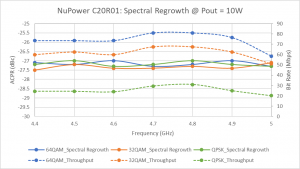Modern communication systems are typically based on a framework of channels, where the frequency spectrum is divided into channels of a defined bandwidth and each signal is assigned to a particular channel. This is analogous to a highway system being divided into lanes. On a highway, it is undesirable for a car to cross into an adjacent lane which is already being occupied by another vehicle, as this would cause a certain amount of “interference”. Fortunately, it is easy to mitigate this occurrence as lanes are clearly defined by bold yellow lines and occupancy can be checked with a simple turn of the head and a mirror glance.
Similar to cars on a highway, it is undesirable for signals to cross into adjacent channels (presented as lanes in our parallel). However, unlike our analogy, invisible electromagnetic signals are far more difficult to detect and so it must be assumed adjacent channels are occupied with other signals, and it is an RF engineer’s duty to ensure that the signal transmitted does not “bleed” into adjacent channels. In our analogy, this would be comparable to a car erratically swerving into an adjacent lane. This may or may not cause “interference” with the other drivers on the road depending on how far across the yellow line the car has transgressed.
For digitally modulated signals transmitted via power amplifiers, which are inherently non-linear, how far “our car” has crossed into the neighboring lane is defined as spectral regrowth (i.e., spectral broadening). If the spectral regrowth is significant enough, it can cause adjacent channel interference. In most cases, an application will define the maximum amount of spectral regrowth that is permissible, whether it is due to FCC regulations or otherwise, by its adjacent channel power ratio (ACPR). ACPR is calculated as the adjacent channel power (Padj) divided by the channel power (Pmain), where Padj and Pmain are calculated by integrating the total power in each channel, based on a given center frequency and channel bandwidth (BW).
Recently, a customer came to NuWaves with an application for a C-band power amplifier which required a minimum RF output power of 10 W, a minimum channel BW of 20 MHz, and a maximum spectral regrowth of ACPR = <27 dBc. The NuPower C20R01 was recommended to the customer, but in order to qualify our amplifier for this application, NuWaves took the initiative to quantify our amplifier’s performance given these requirements. To further confound the technical requirements, the amplifier was required to perform at 24 V—below its typical range of operating voltages of 27-32 V. Fig. 1a-b demonstrated to the customer the throughput they could expect to see while meeting these requirements for three modulation schemes, QPSK, 32QAM, and 64QAM, with a forced peak-to-average-power-ratio (PAPR) of 7 dB. Conditions for the signal generator are given in Fig. 1c.

(a)

(b)

(c)
Figure 1. Measured throughput at various modulation schemes for NuPower C20R01 given requirements of 10 W minimum output power and ACPR <27 dBc: (a) measured throughput while output power shown to be 10 W for test condition where ACPR <27 dBc, (b) measured throughput while ACPR shown to be <27 dBc for test condition where output power is >= 10 W, and (c) signal generator test conditions for Fig. 1a-b.
Here at NuWaves, we are happy to accommodate reasonable requests to provide additional data that is not already included on our website or in our datasheets. If there is a specification you would like clarity on, contact NuWaves today!
—-
NuWaves RF Solutions has developed a wide variety of off-the-shelf RF power amplifiers with rich features to support mission-critical CONOPS in telemetry, ISR, and tactical communication systems applications. Frequency ranges are available from UHF through C-band with output power levels ranging from 5 to 100 W. All NuPower PAs are designed, built and tested in-house under NuWaves’ Quality Management System (QMS) certified to AS9100:2016 Rev D and ISO 9001-2015 standards, which ensures that each product arrives on-time and defect-free. Most models are in-stock. NuWaves also boasts a full suite of state-of-the-art design and simulation tools, test and measurement equipment, prototyping equipment and a full-scale production facility to provide custom solutions to your specifications. Contact NuWaves today to find out more.


